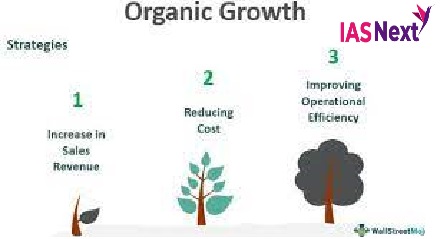CURRENT AFFAIRS
Get the most updated and recent current affair content on Padhaikaro.com
What is ‘Organic’ Growth?
- IAS NEXT, Lucknow
- 22, Nov 2021

Organic Farming is poised to become 75000 cr rupee market by 2025. The Indian organic market is expected to grow at an annual rate of more than 20%. However India’s share in the global organic market is just 1%.
In organic food production synthetic inputs (such as fertilizers, pesticides, hormones, feed additives etc.) are avoided and it relies upon crop rotation, crop residues, animal manures, off-farm organic waste, mineral grade rock additives and biological system of nutrient mobilization and plant protection.
Organic food sector primarily aims at cultivating the land and raising crops in such a way that it keeps the soil alive and in good health by use of organic wastes (crop, animal and farm wastes, aquatic wastes) and other biological materials along with beneficial microbes (bio fertilizers) to release nutrients to crops for increased sustainable production in an eco-friendly and pollution-free environment.
Strength & Potential of Organic food sector:
- It relies on traditional techniques such as crop rotation, green manure, compost and biological. It is accomplished by using farm agronomic, biological and mechanical methods in exclusion of all synthetic off farm inputs.
- It protects the long term fertility of soils by maintaining organic Matter levels and encouraging soil biological activity. It often involves vermiculture and vermi-composting too.
- The biological processes, driven by mycorrhiza, allow the natural production of nutrients in soil throughout growing season.
- Crop Rotation supports a wider range of beneficial insects, soil micro-organisms, and hence, protects species from going extinct.
- It improves soil health and fertility. It requires careful use of water resources hence lead to conservation of water.
- Sustainable and environmentally friendly production method, which has particular advantages for small-scale farmers.
- It helps in conserving bio-diversity and nature resources on the farm and in the surrounding area.
- Farmers in India’s poorest region are recording record rice yields, organic banana yields, etc.
- India has the 9th largest World’s Organic Agricultural Land and the largest number of producers Sikkim has become India's first fully organic state by converting around 75,000 hectares of agricultural land into sustainable cultivation.
However, the emerging threats such as climate change induced global warming; flooding, relative market demand etc. pose serious challenge for the growth & development of organic food sector.
- The cost of cultivation increases as it takes more time and energy to produce than its synthetic input intensive counterpart.
- Specialised farmer training costs, higher processing and inventory holding costs, and increased packaging, logistics and distribution costs add to the price of end products.
- There is low awareness at the producer level on the difference between conventional farming and organic farming.
- At the consumer side there is confusion between natural and organic products and limited understanding of the health benefits of organic food products.
- Growing demand and low supply has further created an inflationary pressure on organic food products; it leads to customer opting for non-organic cheap products.
Hence, it becomes imperative to incentivise farmers for input procurement, value addition including post-harvest infrastructure creation, packaging, branding, publicity, transportation, organic fairs, etc.
Some government initiatives and local level innovations can help achieve these objective in following ways:
- Organic farming schemes such as the National MIssion for Sustainable Agriculture (NMSA) that promotes “location specific” farming systems, it helps make agriculture sustainable.
- Also, Paramparagat Krishi Vikas Yojana (PKVY) that promotes various organic farming models through adoption of organic village by cluster approach and PGS certification.
- It is critical for companies involved in the organic food business to increase awareness among consumers in non-metro cities.
- Creating community-supported agricultural farms or with “grow your own food” programmes.
- Mission Organic Value Chain Development for North East Region (MOVCD-NER) is a Central Sector Scheme, a sub-mission under National Mission for Sustainable Agriculture (NMSA), aims for development of certified organic production in a value chain mode to link growers with consumers and to support the development of entire value chain starting from inputs, seeds, certification, to the creation of facilities for collection, aggregation, processing, marketing and brand building initiative.
- Ministry of Food Processing and Ministry of Women and Child Development jointly initiated the National Organic Food Festival aimed at strengthening organic food produce in the country. It also aimed at encouraging women entrepreneurs in manufacturing organic produce
Conclusion:
Organic food production because of its innovative nature, less harm to environment, and cost effectiveness holds immense potential in the time of rising environmental and global market chain challenges. Hence, organic food sector can be promoted as brand for “local to global” programme besides it will also help to give boost to rural economy and increase farmers income.